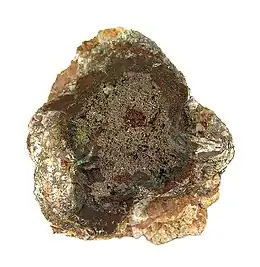Chlorargyrite
Chlorargyrite is the mineral form of silver chloride (AgCl).[5] Chlorargyrite occurs as a secondary mineral phase in the oxidation of silver mineral deposits. It crystallizes in the isometric - hexoctahedral crystal class. Typically massive to columnar in occurrence it also has been found as colorless to variably yellow cubic crystals. The color changes to brown or purple on exposure to light. It is quite soft with a Mohs hardness of 1 to 2 and dense with a specific gravity of 5.55. It is also known as cerargyrite and, when weathered by desert air, as horn silver. Bromian chlorargyrite (or embolite) is also common. Chlorargyrite is water-insoluble.
| Chlorargyrite | |
|---|---|
 | |
| General | |
| Category | Halide |
| Formula (repeating unit) | AgCl |
| IMA symbol | Cag[1] |
| Strunz classification | 3.AA.15 |
| Crystal system | Isometric |
| Crystal class | Hexoctahedral (m3m) H-M symbol (4/m 3 2/m) |
| Space group | Fm3m |
| Identification | |
| Color | Colorless when fresh; alters to bright chartreuse-green, light yellow, light green, grey, violet-brown on exposure to light |
| Crystal habit | Massive to columnar |
| Fracture | Irregular/uneven, sub-conchoidal |
| Tenacity | Sectile |
| Mohs scale hardness | 1.5 - 2.5 |
| Luster | Adamantine, resinous, waxy |
| Streak | White |
| Specific gravity | 5.556 |
| Optical properties | Isotropic |
| Refractive index | n = 2.071 |
| References | [2][3][4] |
It occurs associated with native silver, cerussite, iodargyrite, atacamite, malachite, jarosite and various iron–manganese oxides.[3]
It was first described in 1875 for occurrences in the Broken Hill district, New South Wales, Australia. The rich Bridal Chamber deposit at Lake Valley, Sierra County, New Mexico was almost pure chlorargyrite.[6] The name is from the Greek, chloros for "pale green" and Latin for silver, argentum.[4]
References
- Warr, L.N. (2021). "IMA–CNMNC approved mineral symbols". Mineralogical Magazine. 85 (3): 291–320. Bibcode:2021MinM...85..291W. doi:10.1180/mgm.2021.43. S2CID 235729616.
- Chlorargyrite data on Mindat.org
- "Handbook of Mineralogy" (PDF). Archived from the original (PDF) on 2016-03-04. Retrieved 2017-04-24.
- Chlorargyrite data on Webmineral
- Chisholm, Hugh, ed. (1911). . Encyclopædia Britannica (11th ed.). Cambridge University Press.
- O’Neill, J. Michael; et al. (2002). Geologic Investigations in the Lake Valley Area, Sierra County, New Mexico. Denver, CO: U.S. Department of the Interior, U.S. Geological Survey. Retrieved 3 February 2018.
- Palache, C., H. Berman, and C. Frondel (1951) Dana's system of mineralogy, (7th edition), v. II, pp. 11–15